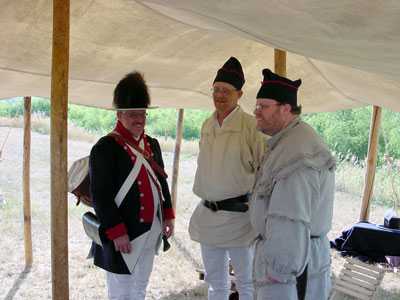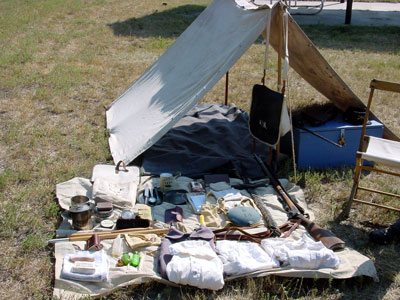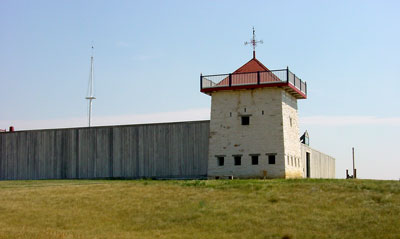
Confluence of the Yellowstone and Missouri Rivers.
Aug. 23, 2003
We discovered that the North Dakota Historical Society has opened a new
Interpretive Center at the confluence of the Yellowstone and Missouri rivers.
The center had its grand opening ceremony today, just as we were driving to it.
So we caught the tail end of a Senator's talk and the ribbon cutting ceremony.
The center itself was a disappointment, but as part of the opening events they
had a "living history encampment" on the grounds. That was very interesting.

The confluence of the Missouri and Yellowstone rivers. The Missouri is
flowing in from the right and out to the left; the Yellowstone appears from
behind the tree covered bluff across the Missouri. This was a major landmark for
Lewis and Clark as they journeyed west and was intended to be a rendezvous point
for them on their journey home. Later we learned that the confluence has shifted
in the last 200 years and the confluence at the time of Lewis and Clark was
about 2 miles further west from here.

These Indians entertained us with their music and traditional costumes at the
living history encampment. I didn't find out which tribe they were from.

These re-enactors are dressed as privates in the Corps of Discovery. The
person on the left is in full dress uniform, which would be worn only when the
Corps was engaged in council with Indians. The middle person is dressed in
summer work clothes, and the one on the right is dressed as a hunter for the
Corps.

The confluence is also important as the location of Fort Buford, which was a
military fort in the second half of the 19th century. Sitting Bull surrendered
here in 1881. These re-enactors are showing army guns and equipment from the
1870s time period.

An 1870s army tent and typical equipment in an army field pack. Dave, how
would you like to carry around all that stuff?

Fort Union Trading Post was established at the confluence only about 20 years after the Lewis and Clark expedition. Steamboats started coming upstream to it in the early 1830s. (It didn't take long for the Americans to start taking over the area.) Indians would bring their buffalo and beaver skins to this fort to trade for manufactured goods from the Americans and goods shipped from as far as Europe and China. This fort has been partially reconstructed on the original site.